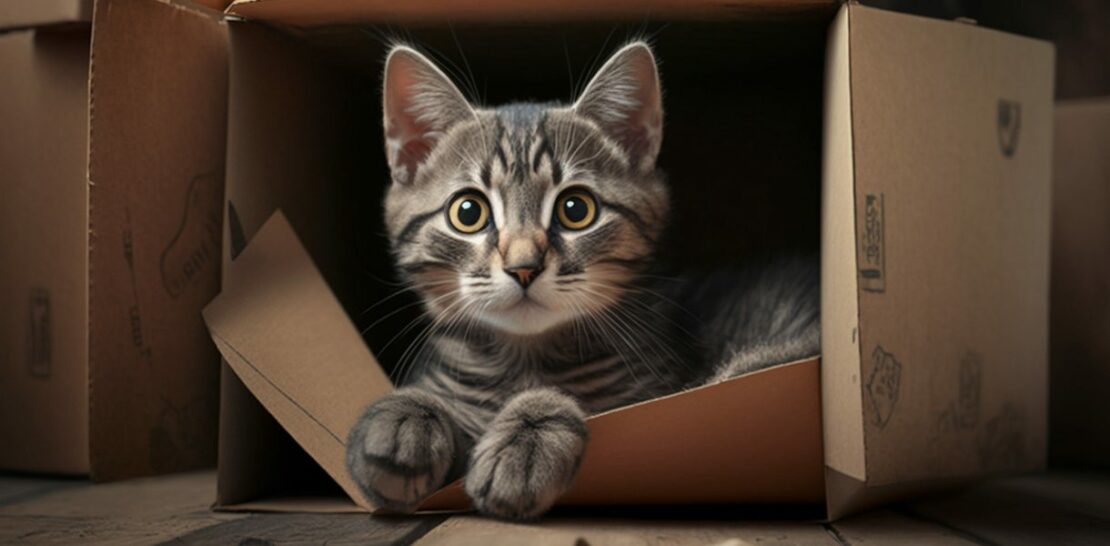Anyone who has ever owned a cat, scrolled through social media, or simply observed feline behavior knows that cats and boxes seem to have an inexplicable and intense bond.
This peculiar passion for cardboard containers continues to baffle and entertain cat enthusiasts and laymen alike.
In this comprehensive exploration, we will delve into the various theories and scientific explanations behind this obsession, shedding light on why cats are so crazy about boxes and unearthing the secrets of this feline fixation.
The Role of Instinct in Feline Box Love
While it might seem whimsical or even absurd to humans, the feline fascination with boxes can be traced back to their wild ancestors and their innate instincts.
- Survival and Hunting Skills: In the wild, cats rely on their natural instincts to survive. This includes locating safe spaces for hiding, stalking prey, and avoiding predators. Boxes provide a secluded and secure environment that satisfies these instincts by simulating the burrows, dens, or hiding spots that wild cats might seek out.
- Stress Relief: Domesticated cats, like their wild counterparts, are sensitive to stress and anxiety. The enclosed and confined space of a box can provide a feeling of safety and comfort, which can greatly reduce stress levels. This may partially explain why cats are drawn to boxes when they are in new or unfamiliar environments.
- Play and Enrichment: Cats are intelligent creatures that require mental and physical stimulation to maintain their wellbeing. Boxes offer a source of enrichment, as they satisfy the feline desire to explore new spaces and can also serve as a toy or object for play. The element of surprise when a cat jumps in and out of a box may also tap into their natural hunting instincts.
Investigating the Science Behind the Box Obsession
While it is clear that instincts play a significant role in the feline love affair with boxes, there are also scientific explanations that delve deeper into the psychological and physiological reasons behind this phenomenon.
- Thermoregulation: Cats have a higher body temperature than humans, and they prefer warmer environments. According to a study by the National Research Council, the thermoneutral zone for domesticated cats is between 30 and 38 degrees Celsius (86 to 100 degrees Fahrenheit). Boxes, especially cardboard ones, provide insulation and help cats maintain their preferred body temperature.
- Curiosity and Exploration: Felines are naturally curious creatures and tend to be attracted to novelty. A new box, or even a familiar one in a different location, can provide a source of intrigue and fascination for a cat. This innate curiosity likely contributes to the seemingly insatiable feline desire to investigate boxes and other enclosed spaces.
- Sensory Stimulation: Cats have an acute sense of smell and are drawn to scents that pique their interest. Cardboard boxes tend to absorb and retain odors, which may appeal to a cat’s olfactory senses and fuel their attraction to these vessels.
Practical Implications of the Feline Box Connection
Understanding the various factors that contribute to the feline affinity for boxes can have practical applications for cat owners, animal shelters, and veterinarians.
- Enrichment and Entertainment: Providing boxes for cats to explore and play in can greatly contribute to their overall happiness and wellbeing. This can be especially beneficial for indoor cats, as it offers a source of mental and physical stimulation that can help prevent boredom and the development of behavioral issues.
- Stress Reduction: Introducing boxes into potentially stressful environments, such as animal shelters or veterinary clinics, can help alleviate anxiety and provide a sense of comfort for cats. Owners can also use boxes to ease the stress of introducing a new cat to the household or acclimating a cat to a new living space.
- Environmental Enrichment and Territory: Cats are territorial creatures and providing them with boxes can help them establish their own space within the home. This can lead to a more harmonious living situation, especially in households with multiple cats or other pets.
Debunking Myths and Misconceptions
While the fascination with boxes is firmly rooted in feline instincts and physiology, there are several misconceptions about cats and boxes thatneed to be addressed and debunked.
- Box Size Matters: Many people believe that cats are only drawn to small, tight-fitting boxes. However, this is not always the case. Cats can be attracted to a variety of box sizes and shapes, depending on their individual preferences and needs. Some cats may prefer larger, more spacious boxes, while others might gravitate towards smaller, more enclosed spaces.
- Cardboard Exclusivity: Although cardboard boxes are particularly popular among felines, their love for enclosed spaces is not limited to this material. Cats can also be drawn to containers made of plastic, wood, or fabric, as long as they provide a sense of security and seclusion.
- Not Just for Laziness: There is a common misconception that cats use boxes as a place to simply lounge around and be lazy. However, as we have explored earlier in this article, there are numerous practical and instinctual reasons behind this behavior. While relaxation may be one aspect of the attraction, it is far from the only driving force behind the feline affinity for boxes.
In conclusion, the feline fascination with boxes is a multifaceted phenomenon that encompasses a range of instinctual, psychological, and physiological factors. By understanding these aspects, we can better appreciate and accommodate the needs and desires of our feline companions, providing them with a more enriching and fulfilling environment. So, the next time you find your cat curled up in a cardboard box or eagerly investigating a new container, take a moment to marvel at the complex interplay of instincts and biology that drive this seemingly simple behavior.




